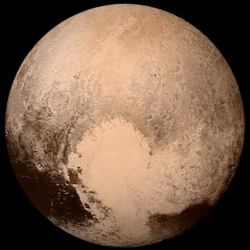
NASA’s New Horizons space probe blasted by Pluto and its moons, the culmination of a 9-year flight that marked humanity’s first visit to the former ninth planet and its companions. Since then, we’ve been reaping the benefits of that trip. The scientists just published their first overview.
As the full report makes clear, Pluto and its moons are far more fascinating and mysterious than anybody had imagined. Pluto and its largest moon Charon are "two of the most complex bodies in our solar system, rivaling the Earth and Mars in terms of the crazy amount of diversity in their geological landforms," says Alan Stern, the head of the New Horizons mission. In addition, the scientists have also announced evidence that both are far from the stagnant, dead worlds we once believed them to be. "We have plenty of evidence of glacial floes and other tectonic features that clearly indicated these bodies have been geologically active on the inside, very recently."
This discovery that Pluto and Charon are geologically active is frankly stunning, Stern says. "Our best understanding is that a dwarf planet like Pluto, after 4.5 billion years of cooling, should not be active," he says, "We really don’t understand why or how. This is a huge paradigm shift that’s violating our knowledge of all planets. There’s clearly something missing in our thinking, and its sending geophysicists back to the drawing-board."
"The New Horizon’s mission is paying off, but my brain hurts," Stern adds. The proof is written across the face of both worlds. In NASA’s now-famous picture of Pluto’s heart-shaped geological feature, Stern points to the curiously smooth left lobe of the heart, which the scientists have preliminarily named Sputnik Planum, or SP. "SP is about the size of Texas, and unlike the rest of Pluto, there’s not a single crater on it," Stern says. That means it must be active, or you’d see the area pockmarked. Plus, the NASA scientists have also found "evidence of tectonics, glacial floes where ice has run out of the mountains, and places ice is swirling around obstacles", all of which points to geologically recent activity, Stern says.
New Horizons uncovered a swath of secondary mysteries to boot. Two of Pluto’s smaller satellites, Nix and Hydra, are curiously reflective, almost twice as shiny as ice-glazed Charon. No one knows why. And Pluto’s layered atmosphere, which is made up "of many layers of haze, which include some exotic molecules like acetylene and ethylene, are much higher than many people even thought possible," Stern says.
